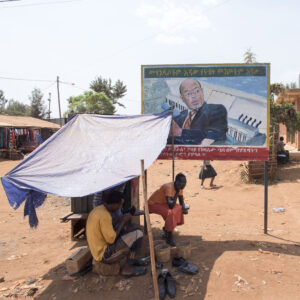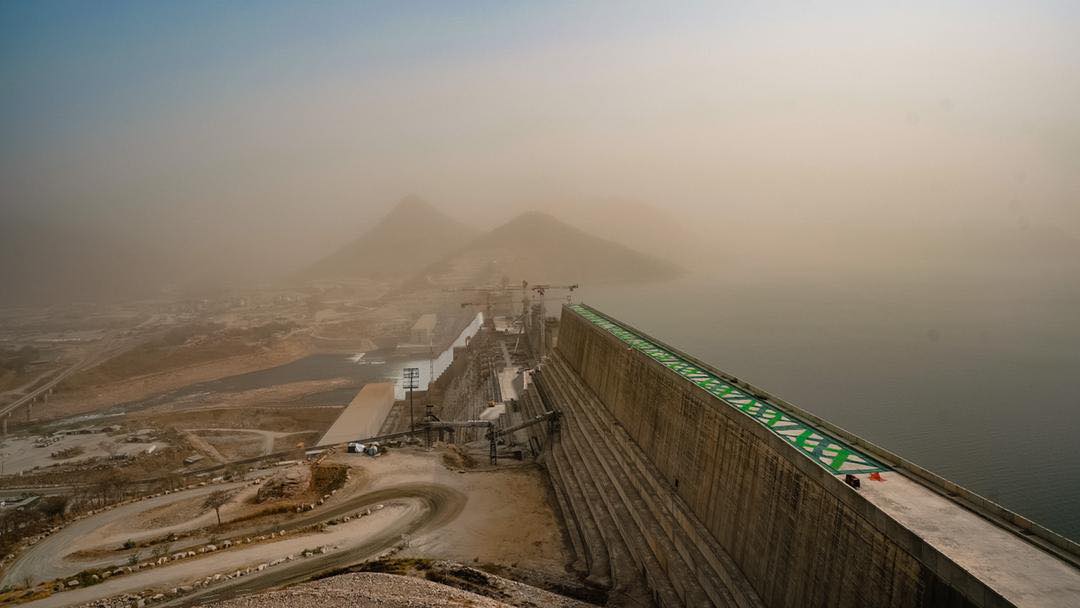by Dr Tom Lavers, Reader in Politics, Global Development Institute
More than 13 years after Ethiopia’s former Prime Minister Meles Zenawi laid its foundation stone, the Grand Ethiopian Renaissance Dam (GERD) is finally nearing completion. A new open access book, Dams, Power and the Politics of Ethiopia’s Renaissance, examines the domestic and international political economy drivers of Ethiopia’s dam building programme and the role of electricity within Ethiopia’s project of state-led development.
Beginning with the long history of Ethiopia’s relationship with the Nile and its ties to downstream riparian countries, this book analyses the dam building efforts of Haile Selassie and the Derg in the second half of the 20th century; the dams’ boom unleashed under the Ethiopian Peoples’ Revolutionary Democratic Front (ERPDF) at the turn of the millennium that culminated in the GERD; and the efforts of the current Prosperity Party government to complete the dam amidst a programme of economic reforms. In doing so, the book argues that the dam building programme, of which the GERD is the largest and most controversial project, is symbolic of the successes and limitations of the EPRDF’s attempts to build a ‘developmental state’ and to transform the Ethiopian economy and society.
Throughout its time in office, the EPRDF governed in a context of political vulnerability. The EPRDF was established by leaders from a minority ethnic group that enjoyed little elite or popular support outside their home region of Tigray. Moreover, a series of political crises in the early 2000s underscored the threat to the ruling elite posed by popular unrest and ethnic divisions. The result was that the EPRDF pursued economic transformation and the broad-based distribution of land, agricultural livelihoods and industrial employment as a means of binding the masses to the regime. For the EPRDF, economic growth and structural transformation were synonymous with the Front’s political survival.
In pursuit of this project of national development, the EPRDF resisted the global trend towards free markets and rolling back the state. Instead, given the imperative of rapid development, the government envisaged a central role for the state in agricultural development, industrial policy and infrastructure investment. The result was the most rapid and sustained economic growth in the country’s history that made it one of the fastest growing economies in the world. A key pillar of the infrastructure drive was a series of ever larger and more complex dams that were primarily focused on provision of low-cost electricity to industry, households and for exports. Hydropower was, furthermore, framed as a means of building a ‘green developmental state’ that would bypass the carbon-intensive growth typical of the early industrialisers. The result was a massive dam building programme which required concessional lending, domestic resource mobilisation and, latterly, also higher-risk non-concessional finance.

A rendering of the Grand Ethiopian Renaissance Dam in Asosa, Benshigagul-Guluz Regional State, Photo by Michael Tsegaye for #EverydayNile
The EPRDF addressed many of the weaknesses that had prevented the past realisation of Ethiopian ambitions on the Blue Nile. First, economic growth during the 2000s increased the resources available for state infrastructure investment. Second, through a cascade of dam projects in the Gibe-Omo basin, political leaders built up a trusted relationship with Salini Impregilo, an Italian civil engineering firm, long active in Ethiopia, that went on to build the GERD. Third, the EPRDF sought to forge internal political cohesion as the basis of a foreign policy focused on securing close relations with global powers and building a coalition of upstream countries to change the balance of power on the Nile, which had previously been dominated by downstream Egypt. The result was that by 2011, Ethiopia had independent access to the finance, technical capacity and political power required to launch the GERD despite longstanding Egyptian opposition.
From one perspective, the EPRDF’s project of state-led development was a major success, delivering rapid socioeconomic development, massively expanding economic infrastructure and providing the political and economic power required to tackle a Blue Nile dam. While the dams’ boom exemplifies the successes of this period, however, it also symbolizes many failings of the EPRDF era. Many of the dam projects (of which the GERD is merely the largest) and other major infrastructure projects, were subject to lengthy delays, major cost overruns, a growing debt burden and proved an inefficient way of addressing the country’s infrastructure needs.
A key challenge was the tension between the urgency with which the political elite pursued infrastructure development and the ability of technical expertise within state agencies to shape decision making. The political imperative of rapid development led the government to launch a bewildering array of ever larger and more ambitious projects. In doing so, however, planning became a political target-setting exercise, bypassing technical capacity in key state agencies. This politically driven over-ambition contributed to the inefficient design of many projects, which are ill suited to meeting Ethiopia’s energy needs, and lengthy delays as projects have pushed the country’s financial and implementation capacities beyond their limit.
These problems relate not just to electricity generation, but also the challenge of bringing the electricity generated to industrial and household users. A political focus on headline grabbing generation was not matched by equivalent investment in transmission and distribution. The result is that investors in Ethiopia’s new industrial parks have struggled to secure reliable electricity, as do the minority of households with grid connections, while more than half of the population remains without a connection. The public promise of the GERD is that massively enhanced electricity generation capacity will translate into mass electricity access. The reality is that grid expansion and connections are likely to lag behind generation for many years to come.
These challenges have multiplied in the wake of the political and economic crisis that engulfed Ethiopia from the mid-2010s. Lengthy delays and inefficiency meant that many infrastructure projects failed to deliver promised economic growth, employment generation and export earnings. Moreover, anti-government protests and factional divisions eventually forced a political transition that brought Abiy Ahmed to power in 2018. These factional divisions within the EPRDF ultimately led to the outbreak of civil war in 2020, as well as unravelling the internal cohesion and international relations that supported Ethiopia’s development project. The result is that the new government has been labouring with political upheaval and the economic cost of completing the final EPRDF mega-projects, including the GERD.
Ethiopia’s ‘developmental state’ was explicitly framed by Meles Zenawi as an alternative to the neo-liberalism of the World Bank and IMF. Yet the irony is that the excesses of this state-led infrastructure boom exposed Ethiopia to a level of debt that has provided these actors with an opening to push for liberalisation and the dismantling of Ethiopia’s state-led development model.
Note: This article gives the views of the author/academic featured and does not represent the views of the Global Development Institute as a whole.
Please feel free to use this post under the following Creative Commons license: Attribution-NonCommercial-NoDerivatives 4.0 International (CC BY-NC-ND 4.0). Full information is available here.
Feature image: PMO – Ethiopia, Public domain, via Wikimedia Commons

